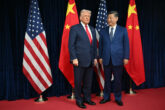July 25, 2019
Innovation in the New Era of Chinese Military Power
China’s State Council Information Office has just released a new national defense white paper, which is the first since the launch of major military reforms in 2015. This document includes an assessment of the international security situation and provides an official explanation of China’s defense policy, missions, military reforms, and defense expenditure. While unsparing in its critique of power politics and American “hegemonism,” the defense white paper also calls for China’s armed forces to “adapt to the new landscape of strategic competition.” In Xi Jinping’s “new era,” the People’s Liberation Army (PLA) is urged to strengthen its preparedness and enhance combat capabilities commensurate with China’s global standing and interests. As the PLA pursues the objective of transforming into “world-class forces” by mid-century, the U.S. military may confront the unprecedented challenge of a potential adversary with formidable and rapidly advancing capabilities.
As an attempt to reassure the international community of China’s commitment to “world peace,” this defense white paper may have limited utility, particularly juxtaposed against the strident signaling of resolve on the “Taiwan question.” This articulation of China’s national defense is direct and explicit in highlighting the willingness to use force to prevent and defeat any attempts at “Taiwan independence.” In particular, China’s quest to achieve “complete reunification” is described as threatened by the potential “interference of external forces,” implicitly the United States, which is often characterized as a powerful adversary in Chinese military writings not intended for an external audience. The U.S. military is the target and often the teacher for Chinese military modernization, and the PLA must be prepared to use “all necessary measures” in order to “safeguard national unity.”
Read the full article in The Diplomat.
More from CNAS
-
Indo-Pacific Security / Energy, Economics & Security
How to Win the Economic War with ChinaTrump's approach to China has run aground, giving Beijing unprecedented advantage in the economic conflict....
By Edward Fishman & Julian Gewirtz
-
America’s Self-Loathing Is a Losing Hand
This article was originally published in The Washington Post.Around 10 years ago, the United States began a historic shift in its grand strategy toward China, abandoning the b...
By David Feith
-
Indo-Pacific Security / Energy, Economics & Security / Technology & National Security
Selling AI Chips Won’t Keep China Hooked on U.S. TechnologyU.S. policy should not rest on the illusion that selling chips can trap China inside the American tech ecosystem....
By Janet Egan
-
Will New Delhi-Beijing Move Beyond Friction Points? | Ex-White Official On India-China Reset
Prime Minister Narendra Modi on Friday said that India and China, as two major economies, must work together to bring stability to the global economic order. NDTV's Gaurie Dwi...
By Lisa Curtis




